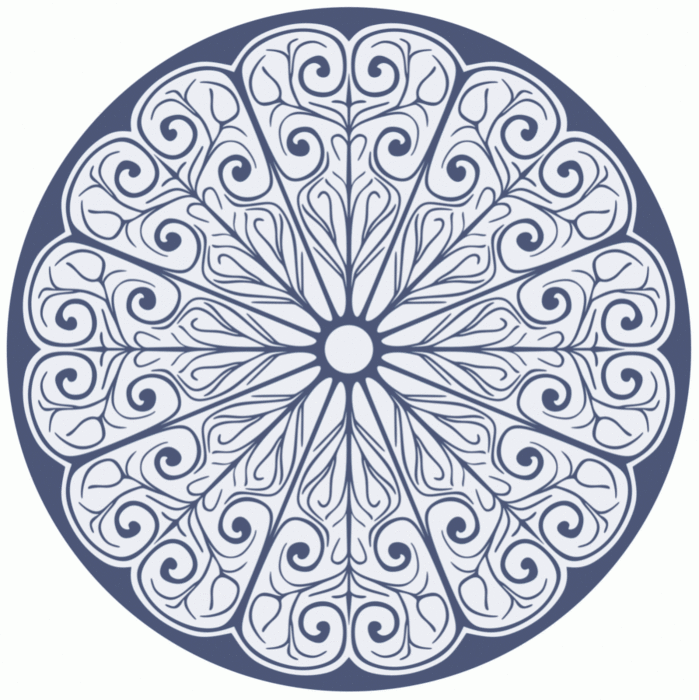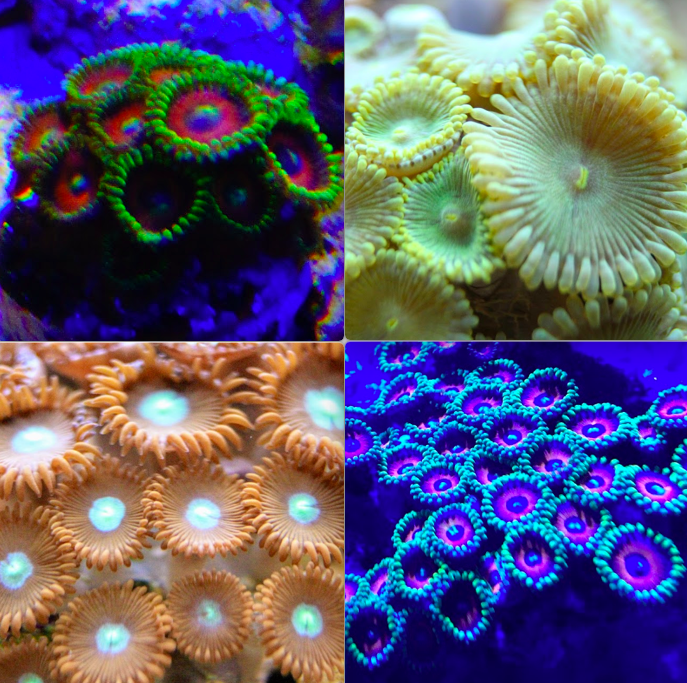Math 281 Modern Algebra II
Symmetry and Wallpaper Groups
Examples of Finite Symmetry Groups • Wallpaper Group PDFs • Wallpaper Group Naming ConventionsExamples of Cyclic and Dihedral Groups
(Hover over the images to zoom in.)
 An Iranian tile from 1444, now housed in the Victoria and Albert Museum, London. This design has 6 rotations, and is an example of C6 symmetry. It is nearly D6, except for the blue and white intertwining design near the center, which prevents any reflections.
An Iranian tile from 1444, now housed in the Victoria and Albert Museum, London. This design has 6 rotations, and is an example of C6 symmetry. It is nearly D6, except for the blue and white intertwining design near the center, which prevents any reflections.
 An example of Persian enamel art, called Meenakari. Ignoring the center image that's a bit unclear, this design has 10 rotations and 10 reflections, so it is an example of D10 (or D20) symmetry.
An example of Persian enamel art, called Meenakari. Ignoring the center image that's a bit unclear, this design has 10 rotations and 10 reflections, so it is an example of D10 (or D20) symmetry.
 This design appears to have several symmetries, but because of the coloration and direction of some diagonal lines, it has no reflections nor non-trivial rotations. Its symmetry group is the trivial group, C1.
This design appears to have several symmetries, but because of the coloration and direction of some diagonal lines, it has no reflections nor non-trivial rotations. Its symmetry group is the trivial group, C1.
 My dog, displaying almost perfect bilateral symmetry (D1) and dignity to spare. He is a papillon, French for "butterfly", and he shares their symmetry. His right ear is no longer standing at attention, so he has been reduced to C1 symmetry, as shown here (when he seems to be getting ready for his new job at Best Buy). No, I do not know why he is always standing up, he just is.
My dog, displaying almost perfect bilateral symmetry (D1) and dignity to spare. He is a papillon, French for "butterfly", and he shares their symmetry. His right ear is no longer standing at attention, so he has been reduced to C1 symmetry, as shown here (when he seems to be getting ready for his new job at Best Buy). No, I do not know why he is always standing up, he just is.
 Many logos are designed to have some non-trivial symmetries, particularly among automotive manufacturers. The logos in the top row all have 0 and 180 degree rotations, but no reflections, so they are C2. The logos in the second row have bilateral symmetry (a vertical reflection), and only the trivial rotation, so they are D1. The bottom row are all dihedral: the first two have three reflections and three rotations (D3), the middle two have two reflections and two rotations (D2), and the last has five reflections and five rotations (D5).
Many logos are designed to have some non-trivial symmetries, particularly among automotive manufacturers. The logos in the top row all have 0 and 180 degree rotations, but no reflections, so they are C2. The logos in the second row have bilateral symmetry (a vertical reflection), and only the trivial rotation, so they are D1. The bottom row are all dihedral: the first two have three reflections and three rotations (D3), the middle two have two reflections and two rotations (D2), and the last has five reflections and five rotations (D5).
 Some flowers displaying various examples of finite symmetry groups. Top left: A flower (spiderwort?) with D3 symmetry (three reflections, three rotations - note the petals overlap). Top right: A columbine flower with D5 symmetry. Bottom left: An orchid, with a single reflection and trivial rotation, so it has D1 symmetry. Bottom right: A vinca, with C5 symmetry (5 rotations only since each petal overlaps its neighbor on the right, though one petal is a little wrinkled).
Some flowers displaying various examples of finite symmetry groups. Top left: A flower (spiderwort?) with D3 symmetry (three reflections, three rotations - note the petals overlap). Top right: A columbine flower with D5 symmetry. Bottom left: An orchid, with a single reflection and trivial rotation, so it has D1 symmetry. Bottom right: A vinca, with C5 symmetry (5 rotations only since each petal overlaps its neighbor on the right, though one petal is a little wrinkled).
 This design has 8 rotations and 8 reflections, so it is an example of D8 (or D16) symmetry.
This design has 8 rotations and 8 reflections, so it is an example of D8 (or D16) symmetry.
 This cactus can't be reflected, but can be rotated 5 times - it is an example of C5 symmetry. It is also an example of the Fibonacci spiral occurring in nature, as are most of its cacti relatives.
This cactus can't be reflected, but can be rotated 5 times - it is an example of C5 symmetry. It is also an example of the Fibonacci spiral occurring in nature, as are most of its cacti relatives.
 Some members of the Echinodermata phylum, which includes starfish, sea urchins, and sand dollars. Most members are satisfied displaying their D5 symmetry. Others, like the confusingly named 'sun starfish', has more ambitious goals (the fellow at bottom right has D13 symmetry, if he holds his legs straight). Starfish that reproduce by division will often grow additional legs before dividing roughly in half. The upper left image is an urchin's skeleton that appears to have been turned into a nightlight. The upper right is a living tuxedo urchin, which is known for its habit of decorating itself with small objects.
Some members of the Echinodermata phylum, which includes starfish, sea urchins, and sand dollars. Most members are satisfied displaying their D5 symmetry. Others, like the confusingly named 'sun starfish', has more ambitious goals (the fellow at bottom right has D13 symmetry, if he holds his legs straight). Starfish that reproduce by division will often grow additional legs before dividing roughly in half. The upper left image is an urchin's skeleton that appears to have been turned into a nightlight. The upper right is a living tuxedo urchin, which is known for its habit of decorating itself with small objects.
Echinoderms are among my favorite animals. Here is a picture of my former tuxedo urchin Fernando, annoying my flame scallop and carrying some shells and algae he found. I currently own two other urchins, Poltergeist and Marsha (short for Marshmallow). I also have several dozen very small starfish.
 Echinoderms are not the only symmetric sea life. These are zoanthids, a type of coral that grows in colonies and related to jellyfish. Each polyp is a single animal capable of surviving on its own, but they are connected by a mat through which they can share nutrients. They are beautiful and easy to care for, but can be extremely toxic and require careful handling. These are a few of my own zoas. They display dihedral symmetry Dn, with n dependent on the number of 'lashes' around each polyp. I've never counted and do not intend to.
Echinoderms are not the only symmetric sea life. These are zoanthids, a type of coral that grows in colonies and related to jellyfish. Each polyp is a single animal capable of surviving on its own, but they are connected by a mat through which they can share nutrients. They are beautiful and easy to care for, but can be extremely toxic and require careful handling. These are a few of my own zoas. They display dihedral symmetry Dn, with n dependent on the number of 'lashes' around each polyp. I've never counted and do not intend to.









Echinoderms are among my favorite animals. Here is a picture of my former tuxedo urchin Fernando, annoying my flame scallop and carrying some shells and algae he found. I currently own two other urchins, Poltergeist and Marsha (short for Marshmallow). I also have several dozen very small starfish.

Wallpaper Group PDFs

If you'd like any of these printed, just let me know.
Wallpaper Group Identification Flow Chart and Fundamental Cells
Group p1
Group p2
Group p4
Group p4m
Group p4g
Group cm
Group cmm
Group pm
Group pg
Group pmm
Group pmg
Group pgg
Group p3
Group p3m1
Group p31m
Group p6
Group p6m
Wallpaper Group Naming
Crystallographic Notation
Crystallography studies infinite periodic symmetries in any dimension. In 3 dimensional space, there are 219 crystallographic groups, or 230 when "chiral" groups are counted as unique. To describe each of these groups, a four character string is used. The first character describes the type of fundamental cell, and the three following characters describe the various non-translational symmetries present.The same notation can be used to describe the 17 wallpaper groups, which can be considered 2 dimensional crystallographic groups, as well as the Frieze groups. Since there are fewer possibilities for fundamental cells and positioning of symmetries, the naming is simpler in these cases. We start by building a four character string, where:
- The first character is either p or c. The p means that the pattern can be created by repeating a ``primitive'' cell that contains the entire pattern. A c means that the primitive cell must be centered in a larger cell in order to see the full lattice structure. All Frieze groups begin with p, and only two wallpaper groups begin with c.
- The second character is a number that denotes the order of the smallest possible rotation. A 1 means the group has no rotations. Frieze groups will have a 1 or 2 here. Larger orders are possible in wallpaper groups.
- The third character denotes a vertical reflection. This will be a 1 if no reflection is present, m if there is a simple vertical reflection, and g if there is a vertical glide reflection.
- The last character denotes an additional reflection. This will be a 1 if no other reflections are present, m if there is a simple reflection, and g if it is a glide reflection. The axis of this reflection, if it exists, will be at an angle of 180/$n$ degrees, where $n$ is the highest possible order of rotation.
| p111 | p211 | p411 | p4mm | p4gm | c1m1 | p1m1 | p1g1 | p2mm | p2mg | p2gg | c2mm | p311 | p611 | p6mm |
| p1 | p2 | p4 | p4m | p4g | cm | pm | pg | pmm | pmg | pgg | cmm | p3 | p6 | p6m |
Orbifold Signature
This notation is also known as Conway notation as it was devised by the mathematician John Conway in 1992. The description is based on topology, rather than crystallography. Orbifold notation expresses which symmetries are present in the simplest possible description of the pattern. A * character indicates a reflection, an x represents a glide reflection, and a number indicates a rotational symmetry of that order. When a number follows the * character, the rotational centers can be found on reflection axes. A symbol of o indicates that no symmetries are present, aside from translations.As an example, the group with crystallographic notation cmm has three centers of rotation, each of order 2. There are also reflections present. One center of rotation does not lie on a reflection axis, while the others do. Hence, its Conway symbol is 2*22. The group pg, on the other hand, is characterized only by two glide reflections, so its Conway symbol is xx.